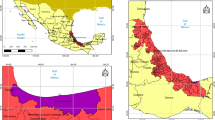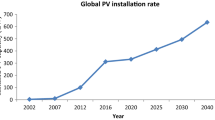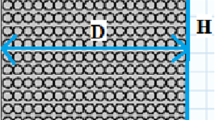Abstract
Compared with the single-stage compression, the two-stage compression cycle shows high efficiency and application potential under both severe heating and refrigerating conditions. Therefore, to improve the performance of the two-stage vapor-compression cycle furtherly, this study introduces three ejector-assisted two-stage compression cycles (E1, E2, and E3), and a conventional two-stage vapor-compression cycles (C1) also selected as the comparison. The energetic and exergetic efficiency of the systems using various refrigerants (R152a, R1234yf, R32 and R290) is investigated and compared based on the validated theoretical model for both the severe refrigerating and heating application. The result shows that the ejector improves the system’s performance significantly. Under the refrigerating mode, System E3 using R32 is recommended to be applied. Compared with Systems C1, E1, and E2, the maximum refrigerating coefficient of performance (COPR) of System E3 using R32 is improved by 16.1, 12.4, and 9.1%, respectively, with the evaporation temperature of −40 °C and condensation of 30 °C. Systems E2 and E1 using R152a are recommended under the heating mode. Compared with Systems C1 and E3, the heating coefficient of performance (COPH) of Systems E1 and E2 using R152 is improved by 3.0 and 4.5%, respectively, with the condensation temperature of 70 °C and evaporation temperature of −5 °C. The result provides a deep understanding of the potential advantages of the ejector-assisted two-stage compression cycle applied in the refrigerating and heating field.












Similar content being viewed by others
Abbreviations
- \(a\) :
-
Circulation area, m2
- C :
-
Conventional two-stage vapor-compression cycle
- COP H :
-
Heating coefficient of performance
- C OP R :
-
Refrigerating coefficient of performance
- E :
-
Ejector-assisted two-stage compression cycle
- EJ:
-
Ejector
- E x d :
-
Exergy loss, kW
- Ėx d :
-
System exergy loss per unit, kW kW−1
- FT:
-
Flash tank
- GWP :
-
Global warming potential
- H:
-
Heat exchanger
- h :
-
Enthalpy, kJ kg−1
- HPC:
-
High-pressure stage compressor
- IHX:
-
Inter heat exchanger
- LPC:
-
Low-pressure stage compressor
- ṁ :
-
Mass flow rate, kg s−1
- N :
-
The ratio of high-pressure stage compression ratio to the low-pressure stage compression ratio
- O DP :
-
Ozone depletion potential
- P :
-
Pressure, MPa
- Q :
-
Load demand, kW
- s :
-
Entropy, kJ (kg K)−1
- T :
-
Tee valve
- T :
-
Temperature, °C
- TV:
-
Throttle valve
- u :
-
Velocity, m s−1
- W :
-
Power consumption, kW
- η d :
-
Efficiency of the diffusion process in ejector
- η m n :
-
Efficiency of the motive process in ejector
- η s :
-
Isentropic efficiency of the compressor
- η s n :
-
Efficiency of the suction process in ejector
- ƞ II :
-
System exergy efficiency
- μ :
-
Entrainment ratio
- ρ :
-
Density, kg m−3
- 0 :
-
Dead state temperature of the environment
- 1,2,3..:
-
State point of the system
- comp:
-
Compressor
- cond:
-
Condensing
- evap:
-
Evaporating
- exh:
-
Exhausting
- H :
-
Heating
- i :
-
Component of system
- is :
-
Isentropic
- R :
-
Refrigerating
- sub:
-
Sub-cooling
- sup:
-
Superheat
- sys:
-
System
- ∆:
-
Increment
References
Maddah S, Safaei MR. Determination of the optimal discharge pressure of the transcritical CO2 heat pump cycles for heating and cooling performances based on new correlation. J Therm Anal Calorim. 2021;145:1537–46. https://doi.org/10.1007/s10973-021-10723-4.
Jung YJ, Oh JW, Han U, Lee H. A comprehensive review of thermal potential and heat utilization for water source heat pump systems. Energy Build. 2022;266: 112124. https://doi.org/10.1016/j.enbuild.2022.112124.
Maddah S, Deymi-Dashtebayaz M, Maddah O. 4E analysis of thermal recovery potential of industrial wastewater in heat pumps: an invisible energy resource from the iranian casting industry sector. J Clean Prod. 2020;265: 121824. https://doi.org/10.1016/j.jclepro.2020.121824.
Zhang XY, Wang EY, Liu LS, Qi CY, Zhen JY, Meng Y. Analysis of the operation performance of a hybrid solar ground-source heat pump system. Energy Build. 2022. https://doi.org/10.1016/j.enbuild.2022.112218.
Duarte WM, Paulino TF, Tavares SG, Maia AA, Machado L. Feasibility of solar-geothermal hybrid source heat pump for producing domestic hot water in hot climates. Int J Refrig. 2021;124:184–96. https://doi.org/10.1016/j.ijrefrig.2020.12.022.
Maddah S, Goodarzi M, Safaei MR. Comparative study of the performance of air and geothermal sources of heat pumps cycle operating with various refrigerants and vapor injection. Alexandria Eng J. 2020;59(6):4037–47. https://doi.org/10.1016/j.aej.2020.07.009.
Xu SX, Chu ZH, Niu JH, Ma GY. Air source heat pump/heat pipe domestic room heating system: design and experimental research. Appl Therm Eng. 2021;192: 116930. https://doi.org/10.1016/j.applthermaleng.2021.116930.
Wang SC, Wang QX, Zhang H, Wang YX, Zhou JH, Zhao PP, Liu JB. Performance analysis on parallel condensing air-source heat pump water heater system. Energy Rep. 2022;8:398–414. https://doi.org/10.1016/j.egyr.2022.01.212.
Chua KJ, Chou SK, Yang WM. Advances in heat pump systems: a review. Appl Energy. 2010;87(12):3611–24. https://doi.org/10.1016/j.apenergy.2010.06.014.
Bertsch SS, Groll EA, Bouffard D, Hutzel W. Review of air-source heat pumps for low temperature climates. In 8th International Energy Agency Heat Pump Conference. 2005.
Redón A, Navarro-Peris E, Pitarch M, Gonzálvez-Macia J, Corberán JM. Analysis and optimization of subcritical two-stage vapor injection heat pump systems. Appl Energy. 2014;124:231–40. https://doi.org/10.1016/j.apenergy.2014.02.066.
Wei WZ, Ni L, Zhou CH, Yao Y, Xu LF, Yang YH. Performance analysis of a quasi-two stage compression air source heat pump in severe cold region with a new control strategy. Appl Therm Eng. 2020;174: 115317. https://doi.org/10.1016/j.applthermaleng.2020.115317.
Bertsch SS, Groll EA. Two-stage air-source heat pump for residential heating and cooling applications in northern US climates. Int J Refrig. 2008;31(7):1282–92. https://doi.org/10.1016/j.ijrefrig.2008.01.006.
Aikins KA, Lee SH, Choi JM. Technology review of two-stage vapor compression heat pump system. Int J Air-Cond Refrig. 2013;21(03):1330002. https://doi.org/10.1142/S2010132513300024.
Jiang S, Wang SG, Yu Y, Ma ZJ, Wang JH. Further analysis of the influence of interstage configurations on two-stage vapor compression heat pump systems. Appl Therm Eng. 2021;184: 116050. https://doi.org/10.1016/j.applthermaleng.2020.116050.
Kwon O, Cha D, Park C. Performance evaluation of a two-stage compression heat pump system for district heating using waste energy. Energy. 2013;57:375–81. https://doi.org/10.1016/j.energy.2013.05.012.
Rad EA, Maddah S. Entropic optimization of the economizer’s pressure in a heat pump cycle integrated with a flash-tank and vapor-injection system. Int J Refrig. 2019;97:56–66. https://doi.org/10.1016/j.ijrefrig.2018.09.018.
Jiang S, Wang SG, Jin X, Yu Y. Optimum compressor cylinder volume ratio for two-stage compression air source heat pump systems. Int J Refrig. 2016;67:77–89. https://doi.org/10.1016/j.ijrefrig.2016.03.012.
Jin X, Zhang K, Liu ZY, Li XY, Jiang S. Numerical research on coupling performance of inter-stage parameters for two-stage compression system with injection. Appl Therm Eng. 2018;128:1430–45. https://doi.org/10.1016/j.applthermaleng.2017.09.126.
Sx X, Gy M. Working performance of R-32 two-stage compression system in domestic air-conditioner. Energy Build. 2015;93:324–31. https://doi.org/10.1016/j.enbuild.2015.02.009.
Sx X, Gy M. Experimental study on two-stage compression refrigeration/heat pump system with dual-cylinder rolling piston compressor. Appl Therm Eng. 2014;62(2):803–8. https://doi.org/10.1016/j.applthermaleng.2013.09.035.
Jiang S, Wang SG, Jin X, Zhang TF. A general model for two-stage vapor compression heat pump systems. Int J Refrig. 2015;51:88–102. https://doi.org/10.1016/j.ijrefrig.2014.12.005.
Wang BL, Cheng Z, Shi WX, Li XT. Optimal volume ratio of two-stage vapour compression system using zeotropic refrigerant. Int J Refrig. 2019;98:343–53. https://doi.org/10.1016/j.ijrefrig.2018.11.021.
Sx X, Gy M. Exergy analysis for quasi two-stage compression heat pump system coupled with ejector. Exp Therm Fluid Sci. 2011;35(4):700–5. https://doi.org/10.1016/j.expthermflusci.2011.01.004.
Yang LW, Xu RJ, Hua N, Xia Y, Zhou WB, Yang T, Belyayev Y, Wang HS. Review of the advances in solar-assisted air source heat pumps for the domestic sector. Energy Convers Manag. 2021;247: 114710. https://doi.org/10.1016/j.enconman.2021.114710.
Cao X, Liang XY, Shao LL, Zhang CL. Performance analysis of an ejector-assisted two-stage evaporation single-stage vapor-compression cycle. Appl Therm Eng. 2022;205: 118005. https://doi.org/10.1016/j.applthermaleng.2021.118005.
Luo BJ, Zou P. Performance analysis of different single stage advanced vapor compression cycles and refrigerants for high temperature heat pumps. Int J Refrig. 2019;104:246–58. https://doi.org/10.1016/j.ijrefrig.2019.05.024.
Xing MB, Yan G, Yu JL. Performance evaluation of an ejector subcooled vapor-compression refrigeration cycle. Energy Convers Manag. 2015;92:431–6. https://doi.org/10.1016/j.enconman.2014.12.091.
Rostamzadeh H, Rostamzadeh J, Matin PS, Ghaebi H. Novel dual-loop bi-evaporator vapor compression refrigeration cycles for freezing and air-conditioning applications. Appl Therm Eng. 2018;138:563–82. https://doi.org/10.1016/j.applthermaleng.2018.04.085.
Xing MB, Yan G, Yu JL. Performance evaluation of an ejector subcooled vapor-compression refrigeration cycle. Energy Convers Manage. 2015;92:431–6. https://doi.org/10.1016/j.enconman.2014.12.091.
Sarkar J. Performance analyses of novel two-phase ejector enhanced multi-evaporator refrigeration systems. Appl Therm Eng. 2016;110:1635–42. https://doi.org/10.1016/j.applthermaleng.2016.08.163.
Li FL, Tian Q, Wu CZ, Wang XY, Lee JM. Ejector performance prediction at critical and subcritical operational modes. Appl Therm Eng. 2017;115:444–54. https://doi.org/10.1016/j.applthermaleng.2016.12.116.
Liu J, Lin Z. A novel dual-temperature ejector-compression heat pump cycle-exergetic and economic analyses. Int J Refrig. 2021;126:155–67. https://doi.org/10.1016/j.ijrefrig.2021.01.005.
Chen JH, Yu JL. Theoretical analysis on a new direct expansion solar assisted ejector-compression heat pump cycle for water heater. Sol Energy. 2017;142:299–307. https://doi.org/10.1016/j.solener.2016.12.043.
Li HS, Cao F, Bu XB, Wang LB, Wang XL. Performance characteristics of R1234yf ejector-expansion refrigeration cycle. Appl Energy. 2014;121:96–103. https://doi.org/10.1016/j.apenergy.2014.01.079.
Huang BJ, Chang JM, Wang CP, Petrenko VA. A 1-D analysis of ejector performance. Int J Refrig. 1999;22(5):354–64. https://doi.org/10.1016/S0140-7007(99)00004-3.
Del Valle JG, Jabardo JS, Ruiz FC, Alonso JSJ. An experimental investigation of a R-134a ejector refrigeration system. Int J Refrig. 2014;46:105–13. https://doi.org/10.1016/j.ijrefrig.2014.05.028.
Sarkar J. Geometric parameter optimization of ejector-expansion refrigeration cycle with natural refrigerants. Int J Energy Res. 2010;34(1):84–94. https://doi.org/10.1002/er.1558.
Atmaca AU, Erek A, Ekren O. Impact of the mixing theories on the performance of ejector expansion refrigeration cycles for environmentally-friendly refrigerants. Int J Refrig. 2019;97:211–25. https://doi.org/10.1016/j.ijrefrig.2018.09.013.
Liu J, Tian X, Lin Z. 4E analyses of novel dual-heat source/sink ejector-compression heat pump system. Build Environ. 2021. https://doi.org/10.1016/j.buildenv.2021.107787.
Sarkar J. Performance characteristics of natural-refrigerants-based ejector expansion refrigeration cycles. Proc Inst Mech Eng, Part A: J Power Energy. 2009;223(5):543–50. https://doi.org/10.1243/09576509JPE753.
Liu J, Zhou L, Lin Z, Zhang X. Performance evaluation of low GWP large glide temperature zeotropic mixtures applied in air source heat pump for DHW production. Energy Convers Manag. 2022;274:116457. https://doi.org/10.1016/j.enconman.2022.116457.
Zehnder M. Efficient air-water heat pumps for high temperature lift residential heating, including oil migration aspects. No. THESIS. EPFL, 2004.
Nikolaidis C, Probert D. Exergy-method analysis of a two-stage vapour-compression refrigeration-plants performance. Appl Energy. 1998;60(4):241–56. https://doi.org/10.1016/S0306-2619(98)00030-0.
Al-Sayyab AKS, Navarro-Esbrí J, Mota-Babiloni A. Energy, exergy, and environmental (3E) analysis of a compound ejector-heat pump with low GWP refrigerants for simultaneous data center cooling and district heating. Int J Refrig. 2022;133:61–72. https://doi.org/10.1016/j.ijrefrig.2021.09.036.
Boumaraf L, Haberschill P, Lallemand A. Investigation of a novel ejector expansion refrigeration system using the working fluid R134a and its potential substitute R1234yf. Int J refrig. 2014;45:148–59. https://doi.org/10.1016/j.ijrefrig.2014.05.021.
NIST Standard Reference Database 23: Reference Fluid Thermodynamic and Transport Properties-REFPROP, Version 8.0.
Jeon Y, Kim S, Lee SH, Chung HJ, Kim Y. Seasonal energy performance characteristics of novel ejector-expansion air conditioners with low-GWP refrigerants. Appl Energy. 2020;278: 115715. https://doi.org/10.1016/j.apenergy.2020.115715.
Antunes AHP, Bandarra FE, Mendonza OSH, Souza LMP, Bertoni MAR. Experimental evaluation of refrigerants R290, R32 and R410a in a refrigeration system originally designed for R22. International Conference on Heat Transfer, Fluid Mechanics and Thermodynamics. 2014. http://hdl.handle.net/2263/44607
Cao Y, Dhahad HA, Mohamed AM, Anqi AE. Thermo-economic investigation and multi-objective optimization of a novel enhanced heat pump system with zeotropic mixture using NSGA-II. Appl Therm Eng. 2021;194: 116374. https://doi.org/10.1016/j.applthermaleng.2020.116374.
Gond RK, Chaudhary RP, Khan MA, Jain G. Performance and exergy analysis of vapour compression refrigeration system using various alternative of R134a. Int Res J Eng Tech. 2016;3(5):187–93.
Chen XW, Liang K, Li ZH, Zhao Y, Xu J, Jiang H. Experimental assessment of alternative low global warming potential refrigerants for automotive air conditioners application. Case Stud Therm Eng. 2020;22: 100800. https://doi.org/10.1016/j.csite.2020.100800.
Chopra K, Sahni V, Mishra RS. Energy, exergy and sustainability analysis of two-stage vapour compression refrigeration system. J Therm Eng. 2015;1(4):440–5. https://doi.org/10.18186/jte.95418.
Sun J, Li WH, Cui B. Energy and exergy analyses of R513a as a R134a drop-in replacement in a vapor compression refrigeration system. Int J Refrig. 2020;112:348–56. https://doi.org/10.1016/j.ijrefrig.2019.12.014.
Baskaran A, Mathews PK. Thermal analysis of vapour compression refrigeration system with R152a and its blends R429A, R430A, R431A and R435A. Int J Sci Eng Res. 2012;3(10):1–8.
Acknowledgements
The work described in this paper is supported by the Fundamental Research Funds for the Jiangsu Province fundamental research project (Grant No. BK20230846) and Jiangsu Province innovation capacity project (Grant No.BM2023013-3)
Author information
Authors and Affiliations
Corresponding author
Additional information
Publisher's Note
Springer Nature remains neutral with regard to jurisdictional claims in published maps and institutional affiliations.
Appendix A: Models of system components
Appendix A: Models of system components

Rights and permissions
Springer Nature or its licensor (e.g. a society or other partner) holds exclusive rights to this article under a publishing agreement with the author(s) or other rightsholder(s); author self-archiving of the accepted manuscript version of this article is solely governed by the terms of such publishing agreement and applicable law.
About this article
Cite this article
Liu, J., Shi, J., Qiu, B. et al. Energy and exergy analysis of various ejector-assisted two-stage compression heat pumps applied in various conditions. J Therm Anal Calorim 149, 3331–3345 (2024). https://doi.org/10.1007/s10973-024-12908-z
Received:
Accepted:
Published:
Issue Date:
DOI: https://doi.org/10.1007/s10973-024-12908-z




